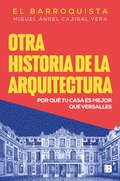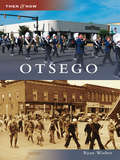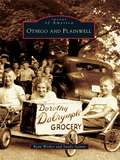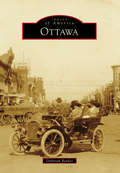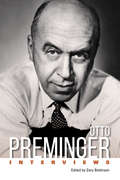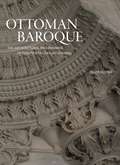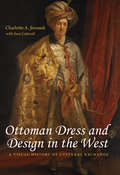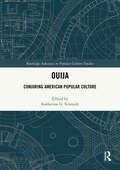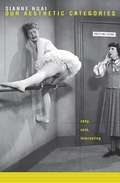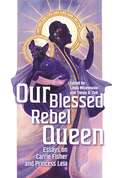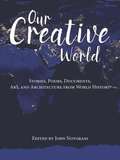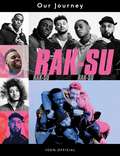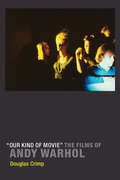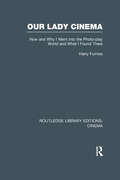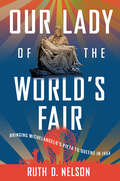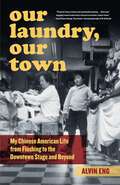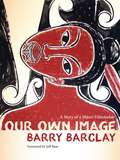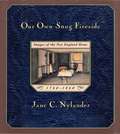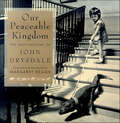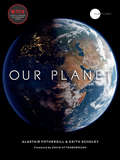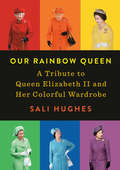- Table View
- List View
Otra historia de la arquitectura: Por qué tu casa es mejor que Versalles
by Miguel Ángel Cajigal Vera (El Barroquista)Tras el éxito de Otra historia del arte, vuelve El Barroquista con un libro imprescindible que nos invita a reflexionar sobre por qué la arquitectura es el mejor antídoto contra el olvido histórico. ¿Sabes por qué en tu casa vives mejor que Catalina la Grande en el palacio de invierno de San Petersburgo o que Luis XVI en Versalles? ¿Por qué la reina Isabel II de Inglaterra se largaba en cuanto podía de su residencia oficial a su castillo privado con habitaciones mucho más pequeñas? ¿Qué lecciones y polémicas oculta la famosa torre Eiffel? La casa en la que te acuestas y despiertas cada día es arquitectura. La escuela en la que estudiaste es arquitectura. Igual que lo es la oficina en la que trabajas, el gimnasio, el cine, la discoteca o los museos en los que pasas tu tiempo libre… La arquitectura nos acompaña -de manera más o menos evidente- en cada uno de nuestros pasos cotidianos, e influye en nuestras vidas más que cualquier otra disciplina creativa. Y, sin embargo… ¡no le prestamos ninguna atención! Este libro reúne conceptos fundamentales y todas las claves para analizar la arquitectura más allá de los clichés, nos enseña a apreciar los diferentes tipos de construcciones para entender cómo cada una de ellas se pensó para satisfacer distintas funciones según la época y lugar y nos abre los ojos a las diferencias sociales y culturales a través de la historia de los edificios.
Otra historia del arte: No pasa nada si no te gustas Las Meninas
by Miguel Ángel Cajigal Vera (El Barroquista)La Historia del Arte con uno de los grandes divulgadores de España: @ElBarroquista. Cualquiera que haya visitado un museo o haya hojeado un libro sobre arte habrá escuchado o leído frases rimbombantes y categóricas como «Nos encontramos ante la gran obra maestra del siglo XX», «Este artista es un genio» o «Aquella pintura cambió el mundo». Esta concepción de la creación artística -basada en la aceptación de un canon preestablecido que privilegia unos estilos específicos y encumbra unas firmas concretas-, lejos de favorecer el aprendizaje y hacer el arte más accesible, ha encorsetado el placer del público general y ha condicionado su gusto. En este libro, el historiador del arte Miguel Ángel Cajigal Vera -conocido como El Barroquista en su labor divulgativa- propone una nueva manera de acercarnos a esta disciplina y nos invita a disfrutar del arte sin prejuicios y con total libertad. Otra historia del arte es un ensayo estimulante que nos abre las puertas al museo particular del autor, donde conoceremos historias fascinantes y obras personalísimas, como las de Maurizio Cattelan, Teresa Margolles, Piero Manzoni o Fiona Banner, junto a piezas muy reconocidas de Guo Xi, Frida Kahlo o Artemisia Gentileschi. Y tras finalizar la lectura comprenderemos por qué no pasa nada si no nos gustan Las meninas.
Otsego
by Ryan WieberOtsego has a rich and storied past as one of the earliest settlements in southwest Michigan. Founded in 1831, its character has been shaped by a history filled with agriculture, tourism, fascinating people, and remarkable commerce--particularly the manufacturing of paper. Otsego has seen the rise and fall and recent rebirth of the local papermaking industry, and it is now poised to progress through the 21st century with a renewed sense of vigor.
Otsego and Plainwell (Images of America)
by Ryan Wieber Sandy StammIn 1831, Samuel Foster and his family built a log house near the rapids of the Kalamazoo River at what is now downtown Otsego. Soon others interested in utilizing the power afforded by the river set up sawmills and grain mills for newly arriving settlers, and the beginnings of a town quickly took shape. In the 1900s, Otsego became synonymous with the paper industry, and for a while, seven paper mills were in operation at the same time. Plainwell, originally called Plainfield and the Junction, situated itself at the crossroads of the old plank roads that led to Grand Rapids, Kalamazoo, and Allegan. Here too, the paper industry played an important part in the growth of Plainwell. Since the downtown area is completely surrounded by the Kalamazoo River and a millrace, it is now referred to as the Island City." Plainwell's historic heritage is evident today through its quaint downtown architecture and beautifully restored neighborhood homes. Otsego and Plainwell have grown up close to each other and share their stories, families, and traditions."
Ottawa
by Deborah BarkerOttawa was founded in 1864. Located in the Marais des Cygnes River Valley, the area's rich soil and lush grass made it well suited for growing crops and pasturing livestock. The community's first cultural center was Ottawa University, which was chartered in 1865 and built on land exchanged by the Ottawa Indians for the promise of an education for their children. Two railroads later arrived, the Lawrence, Leavenworth & Galveston in 1868 and the Missouri Pacific in 1880, spurring industrial development. Images of America: Ottawa highlights early settlers, prominent industries, noteworthy institutions, and devastating natural disasters. Using vintage photographs, this history features local memories and milestones, capturing everything from the famous Ottawa Chautauqua Assemblies, held annually from 1883 to 1914 in Forest Park, to the emerging distribution centers that have shaped the area today.
Otto Preminger: Interviews (Conversations with Filmmakers Series)
by Gary BettinsonOtto Preminger (1905–1986), whose Hollywood career spanned the 1930s through the 1970s, is popularly remembered for the acclaimed films he directed, among which are the classic film noir Laura, the social-realist melodrama The Man with the Golden Arm, the CinemaScope musical Carmen Jones, and the riveting courtroom drama Anatomy of a Murder. As a screen actor, he forged an indelible impression as a sadistic Nazi in Billy Wilder’s Stalag 17 and as the diabolical Mr. Freeze in television’s Batman. He is remembered, too, for drastically transforming Hollywood’s industrial practices. With Exodus, Preminger broke the Hollywood blacklist, controversially granting screen credit to Dalton Trumbo, one of the exiled “Hollywood Ten.” Preminger, a committed liberal, consistently shattered Hollywood’s conventions. He routinely tackled socially progressive yet risqué subject matter, pressing the Production Code’s limits of permissibility. He mounted Black-cast musicals at a period of intense racial unrest. And he embraced a string of other taboo topics—heroin addiction, rape, incest, homosexuality—that established his reputation as a trailblazer of adult-centered storytelling, an enemy of Hollywood puritanism, and a crusader against censorship. Otto Preminger: Interviews compiles nineteen interviews from across Preminger’s career, providing fascinating insights into the methods and mindset of a wildly polarizing filmmaker. With remarkable candor, Preminger discusses his filmmaking practices, his distinctive film style, his battles against censorship and the Hollywood blacklist, his clashes with film critics, and his turbulent relationships with a host of well-known stars, from Marilyn Monroe and Frank Sinatra to Jane Fonda and John Wayne.
Ottoman Baroque: The Architectural Refashioning of Eighteenth-Century Istanbul
by Unver RustemA new approach to late Ottoman visual culture and its place in the worldWith its idiosyncratic yet unmistakable adaptation of European Baroque models, the eighteenth-century architecture of Istanbul has frequently been dismissed by modern observers as inauthentic and derivative, a view reflecting broader unease with notions of Western influence on Islamic cultures. In Ottoman Baroque—the first English-language book on the topic—Ünver Rüstem provides a compelling reassessment of this building style and shows how between 1740 and 1800 the Ottomans consciously coopted European forms to craft a new, politically charged, and globally resonant image for their empire’s capital.Rüstem reclaims the label “Ottoman Baroque” as a productive framework for exploring the connectedness of Istanbul’s eighteenth-century buildings to other traditions of the period. Using a wealth of primary sources, he demonstrates that this architecture was in its own day lauded by Ottomans and foreigners alike for its fresh, cosmopolitan effect. Purposefully and creatively assimilated, the style’s cross-cultural borrowings were combined with Byzantine references that asserted the Ottomans’ entitlement to the Classical artistic heritage of Europe. Such aesthetic rebranding was part of a larger endeavor to reaffirm the empire’s power at a time of intensified East-West contact, taking its boldest shape in a series of imperial mosques built across the city as landmarks of a state-sponsored idiom.Copiously illustrated and drawing on previously unpublished documents, Ottoman Baroque breaks new ground in our understanding of Islamic visual culture in the modern era and offers a persuasive counterpoint to Eurocentric accounts of global art history.
Ottoman Dress and Design in the West: A Visual History of Cultural Exchange
by Charlotte Jirousek Sara Catterall&“This amply illustrated, attractive book is valuable for dress history scholars . . . [an] ideal textbook for courses on clothing and cultural history.&” —The Journal of Dress History Ottoman Dress and Design in the West is a richly illustrated exploration of the relationship between West and Near East through the visual culture of dress. Charlotte Jirousek examines the history of dress and fashion in the broader context of western relationships with the Mediterranean world from the dawn of Islam through the end of the twentieth century. The significance of dress is made apparent by the author&’s careful attention to its political, economic, and cultural context. The reader comes to understand that dress reflects not simply the self and one&’s relation to community but also that community&’s relation to a wider world through trade, colonization, religion, and technology. The chapters provide broad historical background on Ottoman influence and European exoticization of that influence, while the captions and illustrations provide detailed studies of illuminations, paintings, and sculptures to show how these influences were absorbed into everyday living. Through the medium of dress, Jirousek details a continually shifting Ottoman frontier that is closely tied to European and American history. In doing so, she explores and celebrates an essential source of influence that for too long has been relegated to the periphery.
Ouija: Conjuring American Popular Culture (Routledge Advances in Popular Culture Studies)
by Katherine G. SchmidtTapping into a growing interest in American culture with the occult and new spiritualism, this book is the first scholarly work devoted entirely to the unique place of Ouija in American culture.On the one hand, Ouija has at different moments in history pointed to a deep fascination and openness with the supernatural in the American psyche. On the other hand, Ouija resides squarely outside of orthodox religious belief, and, as we shall see, garners suspicion and even outright rejection from various Christian traditions especially. Thus this cardboard doorway to the supernatural continues to reflect some of the most interesting paradoxes in American life.Bringing together an international team of scholars, this book shows that what qualifies as religious remains an open question, and how Americans continue to grapple with what practices lie within and without the traditions they inherit and pass on.
Our Aesthetic Categories: Zany, Cute, Interesting
by Sianne NgaiIn this radiant study, Sianne Ngai offers a theory of the aesthetic categories that most people use to process the hypercommodified, mass-mediated, performance-driven world of late capitalism, treating them with the same seriousness philosophers have reserved for analysis of the beautiful and the sublime.
Our Beautiful, Fragile World: The Nature and Environmental Photographs of Peter Essick
by Peter Essick"Our Beautiful, Fragile World" features a career-spanning look at the images of photojournalist Peter Essick taken while on assignment for "National Geographic" magazine. In this book, Essick showcases a diverse series of photographs from some of the most beautiful natural areas in the world and documents major contemporary environmental issues, such as climate change and nuclear waste. Each photograph is accompanied by commentary on the design process of the image, Essick's personal photographic experiences, and informative highlights from the research he completed for each story. "Our Beautiful, Fragile World" takes the reader on a journey around the globe, from the Oulanka National Park near the Arctic Circle in Finland to the Adelie penguin breeding grounds in Antarctica. "Our Beautiful, Fragile World" will interest photographers of all skill levels. It carries an important message about conservation, and the photographs provide a compelling look at our environment that will resonate with people of all ages who care about the state of the natural world. Foreword by Jean-Michel Cousteau.
Our Blessed Rebel Queen: Essays on Carrie Fisher and Princess Leia (Contemporary Approaches to Film and Media Series)
by Linda Mizejewski Ken Feil Kristen Anderson Wagner Jennifer M. Fogel Cynthia A. Hoffner Maghan Molloy Jackson Philipp Dominik Keidl Andrew Kemp-Wilcox Slade Kinnecott Sejung Park Tanya D. ZukOur Blessed Rebel Queen: Essays on Carrie Fisher and Princess Leia is the first full-length exploration of Carrie Fisher’s career as actress, writer, and advocate. Fisher’s entangled relationship with the iconic Princess Leia is a focal point of this volume. Editors Linda Mizejewski and Tanya D. Zuk have assembled a collection that engages with the multiple interfaces between Fisher’s most famous character and her other life-giving work. The contributors offer insights into Fisher as science-fiction idol, author, feminist inspiration, and Lucasfilm commodity. Jennifer M. Fogel examines the thorny "ownership" of Fisher’s image as a conflation of fan nostalgia, merchandise commodity, and eventually, feminist icon. Philipp Dominik Keidl looks at how Carrie Fisher and her iconic character are positioned within the male-centric history of Star Wars. Andrew Kemp-Wilcox researches the 2016 controversy over a virtual Princess Leia that emerged after Carrie Fisher’s death. Tanya D. Zuk investigates the use of Princess Leia and Carrie images during the Women’s March as memetic reconfigurations of historical propaganda to leverage political and fannish ideological positions. Linda Mizejewski explores Carrie Fisher’s autobiographical writing, while Ken Feil takes a look at Fisher’s playful blurring of truth and fiction in her screenplays. Kristen Anderson Wagner identifies Fisher’s use of humor and anger to challenge public expectations for older actresses. Cynthia Hoffner and Sejung Park highlight Fisher’s mental health advocacy, and Slade Kinnecott personalizes how Fisher’s candidness and guidance about mental health were especially cherished by those who lacked a support system in their own lives. Our Blessed Rebel Queen is distinct in its interdisciplinary approach, drawing from a variety of methodologies and theoretical frameworks. Longtime fans of Carrie Fisher and her body of work will welcome this smart and thoughtful tribute to a multimedia legend.
Our Creative World: Stories, Poems, Documents, Art, and Architecture from World History
by Notgrass CompanyOur Creative World is part of the Notgrass "From Adam to Us" one-year world history and literature curriculum for students in grades 5-8. It features primary documents that accompany the curriculum, including stories, poems, documents, and pictures of art, artifacts, and architecture. Entries include a short contextual introduction.
Our Gang: A Racial History of The Little Rascals
by Julia LeeIt was the age of Jim Crow, riddled with racial violence and unrest. But in the world of Our Gang, black and white children happily played and made mischief together. They even had their own black and white version of the KKK, the Cluck Cluck Klams—and the public loved it. The story of race and Our Gang, or The Little Rascals, is rife with the contradictions and aspirations of the sharply conflicted, changing American society that was its theater. Exposing these connections for the first time, Julia Lee shows us how much this series, from the first silent shorts in 1922 to its television revival in the 1950s, reveals about black and white American culture—on either side of the silver screen. Behind the scenes, we find unconventional men like Hal Roach and his gag writers, whose Rascals tapped into powerful American myths about race and childhood. We meet the four black stars of the series—Ernie &“Sunshine Sammy&” Morrison, Allen &“Farina&” Hoskins, Matthew &“Stymie&” Beard, and Billie &“Buckwheat&” Thomas—the gang within the Gang, whose personal histories Lee pursues through the passing years and shifting political landscape. In their checkered lives, and in the tumultuous life of the series, we discover an unexplored story of America, the messy, multiracial nation that found in Our Gang a comic avatar, a slapstick version of democracy itself.
Our Journey: Rak Su’s Official Autobiography. The X Factor Winners
by Rak-SuA shout-out to all fans of Rak-Su - this is their story, from where it all began to where they are now, full of exclusive stories and pictures. Make it a special day. Make it a Rak-Su day! __________Rak-Pack! Are you ready for our official story?As long as we've been friends, we've been creating our unique sound of soul, R'n'B, Hip-Hop, Latin and Caribbean music.Keeping the momentum going from our X-Factor journey, we are now performing at sold-out arenas, making more music and having fun!So why not join us on the adventure? Unrivalled access to never-before-seen photos, intimate stories, and behind-the-scenes info - in our first and only memoir!_________Ashley, Jamaal, Myles and Mustafa shot to stardom in 2017 as the first ever male group to win the X-Factor. Since then, the soulful boys have been topping the charts with their eclectic sound, performing at sold-out arenas, touring with global sensation Little Mix, recording their first album and most recently dropping their brand new hit single, Pyro Ting.Join Rak-Su on their journey from ordinary North-West London lads, to victors of one of the world's biggest talent shows in their one and ONLY! OFFICIAL memoir, Our Journey.
Our Kind of Movie: The Films of Andy Warhol
by Douglas CrimpA celebrated writer on contemporary art and queer culture argues that Andy Warhol's films enable us to see differently, and to see a different world.“We didn't think of our movies as underground or commercial or art or porn; they were a little of all of those, but ultimately they were just 'our kind of movie.'”—Andy WarholAndy Warhol was a remarkably prolific filmmaker, creating more than 100 movies and nearly 500 of the film portraits known as Screen Tests. And yet relatively little has been written about this body of work. Warhol withdrew his films from circulation in the early 1970s and it was only after his death in 1987 that they began to be restored and shown again. With Our Kind of Movie Douglas Crimp offers the first single-authored book about the full range of Andy Warhol's films in forty years—and the first since the films were put back into circulation.In six essays, Crimp examines individual films, including Blow Job, Screen Test No. 2, and Warhol's cinematic masterpiece The Chelsea Girls (perhaps the most commercially successful avant-garde film of all time), as well as groups of films related thematically or otherwise—films of seductions in confined places, films with scenarios by Ridiculous Theater playwright Ronald Tavel. Crimp argues that Warhol's films make visible new, queer forms of sociality. Crimp does not view these films as cinéma-vérité documents of Warhol's milieu, or as camera-abetted voyeurism, but rather as exemplifying Warhol's inventive cinema techniques, his collaborative working methods, and his superstars' unique capabilities. Thus, if Warhol makes visible new social relations, Crimp writes, that visibility is inextricable from his making a new kind of cinema.In Our Kind of Movie Crimp shows how Warhol's films allow us to see against the grain—to see differently and to see a different world, a world of difference.
Our Lady Cinema: How and Why I went into the Photo-play World and What I Found There (Routledge Library Editions: Cinema)
by Harry FurnissThis charming classic of film literature was originally published in 1914 and hence represents an early attempt to catalogue the allure of cinema and how the motion picture industry began. This tale of life in the early days of cinema will be of interest to film historians and anyone interested in that period of history. The book outlines the actors, the producers, the studios and the audiences as well as the advertising and regulation at the time with often amusing stories and facts along with the author’s own drawings. Overall this serves as a fascinating introduction to the making of early films, which at the time was a great mystery to most people.
Our Lady of Controversy
by Alicia Gaspar De Alba Alma LópezMonths before Alma López's digital collage Our Lady was shown at the Museum of International Folk Art in 2001, the museum began receiving angry phone calls from community activists and Catholic leaders who demanded that the image not be displayed. Protest rallies, prayer vigils, and death threats ensued, but the provocative image of la Virgen de Guadalupe (hands on hips, clad only in roses, and exalted by a bare-breasted butterfly angel) remained on exhibition. Highlighting many of the pivotal questions that have haunted the art world since the NEA debacle of 1988, the contributors to Our Lady of Controversy present diverse perspectives, ranging from definitions of art to the artist's intention, feminism, queer theory, colonialism, and Chicano nationalism. Contributors include the exhibition curator, Tey Marianna Nunn; award-winning novelist and Chicana historian Emma Pérez; and Deena González (recognized as one of the fifty most important living women historians in America). Accompanied by a bonus DVD of Alma López's I Love Lupe video that looks at the Chicana artistic tradition of reimagining la Virgen de Guadalupe, featuring a historic conversation between Yolanda López, Ester Hernández, and Alma López, Our Lady of Controversy promises to ignite important new dialogues.
Our Lady of the World's Fair: Bringing Michelangelo's "Pietà" to Queens in 1964
by Ruth D. NelsonOur Lady of the World's Fair reveals the remarkable story of how two of New York's most influential leaders persuaded the Vatican to allow one of the world's greatest works of art to leave Europe for the first and only time. Driven by different motives, Robert Moses and Francis Cardinal Spellman had the same vision: to display Michelangelo's masterpiece, the Pietà, in the Vatican's pavilion at the 1964 World's Fair in New York City.As Ruth D. Nelson gracefully showcases, Moses believed this blockbuster would guarantee the fair's financial success. At the same time, Spellman, Cardinal of New York and the spiritual leader of Cold War America's Catholic community, hoped that at a time of domestic strife and global conflict, the Pietà's presence would have a positive spiritual impact on the nation. Although the fair did not turn out to be the financial bonanza that Moses expected, the Pietà drew record crowds of the faithful, art lovers, and the curious.Nelson's fascinating uncovering of the intensive planning that went into designing the pavilion, transporting the art piece across the Atlantic, and coordinating Pope Paul VI's visit to New York in 1965—the first papal visit to the Western Hemisphere—demonstrates the sheer scale and opportunity of the two men's endeavors. Our Lady of the World's Fair depicts the skepticism and fierce criticism that faced the two New York power brokers. Rather than letting the negative weigh them down, they united and called on every resource at their disposal to make this unlikely cultural coup possible.
Our Laundry, Our Town: My Chinese American Life from Flushing to the Downtown Stage and Beyond
by Alvin EngWith humor and grace, the memoir of a first-generation Chinese American in New York City.Our Laundry, Our Town is a memoir that decodes and processes the fractured urban oracle bones of Alvin Eng’s upbringing in Flushing, Queens, in the 1970s. Back then, his family was one of the few immigrant Chinese families in a far-flung neighborhood in New York City. His parents had an arranged marriage and ran a Chinese hand laundry. From behind the counter of his parents’ laundry and within the confines of a household that was rooted in a different century and culture, he sought to reconcile this insular home life with the turbulent yet inspiring street life that was all around them––from the faux martial arts of TV’s Kung Fu to the burgeoning underworld of the punk rock scene.In the 1970s, NYC, like most of the world, was in the throes of regenerating itself in the wake of major social and cultural changes resulting from the counterculture and civil rights movements. And by the 1980s, Flushing had become NYC’s second Chinatown. But Eng remained one of the neighborhood’s few Chinese citizens who did not speak fluent Chinese. Finding his way in the downtown theater and performance world of Manhattan, he discovered the under-chronicled Chinese influence on Thornton Wilder’s foundational Americana drama, Our Town. This discovery became the unlikely catalyst for a psyche-healing pilgrimage to Hong Kong and Guangzhou, China—his ancestral home in southern China—that led to writing and performing his successful autobiographical monologue, The Last Emperor of Flushing. Learning to tell his own story on stages around the world was what proudly made him whole.As cities, classrooms, cultures, and communities the world over continue to re-examine the parameters of diversity, equity, and inclusion, Our Laundry, Our Town will reverberate with a broad readership.
Our Own Image: A Story of a Maori Filmmaker
by Barry BarclayAcclaimed Maori filmmaker Barry Barclay&’s Our Own Image relates the experiences of making his documentaries and his critically acclaimed feature-length film Ngati (1987), widely credited as the first fiction feature by a member of an indigenous community. Barclay details his views on the process of filmmaking within his own Maori community and discusses how his work differed from popular cinema, advocating for indigenous control, participation, and perspectives in media.Our Own Image gives an in-depth depiction of the changes Barclay&’s approach contributed to the field of documentaries, as well as displaying the respect for community Barclay brought to his filming technique. His insistence on letting people speak for themselves demonstrated authenticity to audiences, creating awareness of indigenous cinema in New Zealand and worldwide.
Our Own Snug Fireside: Images of the New England Home, 1760-1860
by Jane NylanderThis charming book portrays domestic life in New England during the century between the American Revolution and the Civil War. Drawing on diaries, letters, wills, newspapers, and other sources, Jane C. Nylander provides intimate details about preparing dinner, spinning and weaving textiles, washing and ironing laundry, planning a social outing, and exchanging food and services. Probing behind the many myths that have grown up about this era, Nylander reveals the complex reality of everyday life in old New England.
Our Peaceable Kingdom: The Photographs of John Drysdale
by John DrysdaleA collection of gorgeous photographs depicting the loving bond between humans and various species of animals.John Drysdale's photographs are exciting, tender, hilarious, often exhilarating - but for more than the obvious reasons. Certainly it's not every day that one sees a lion that's befriended a Boston terrier. Maybe elephants don't usually go fishing, and parrots generally don't tend to lounge around in beach chairs, next to their human companions. But in the "peaceable kingdom" of John Drysdale, surprisingly unique alliances flourish. His photographs are whimsical and charming, but also carry a very important, necessary truth - the essential bonds of friendship transcend appearances, expectations, and traditions. Cats can love mice, bulldogs can rear squirrels, and foxes can protect chicks.With a refreshingly honest eye, Drysdale has captured the many ways in which the creatures that inhabit the earth bring one another comfort and happiness. Never mind that a burro and a boy are curled up on the sofa, or that a chimpanzee is sunbathing with his human family by the pool. Friendship is where you find it. The familiarity and love expressed in Drysdale's work is heartfelt and very real - as the endnotes explain, the exotic animals that are his subjects were often orphaned as babies, and reared along with the humans and other animals in the photographs.Since his earliest photographs of children frolicking on the cobblestoned streets of London, Drysdale's wonderfully illustrious career has spanned close to fifty years. And in Our Peaceable Kingdom, for the first time, 100 of his most memorable images are collected in one beautiful volume, destined to become a favorite on the shelves of children, adults, animal lovers, and anyone who appreciates a good friend.
Our Planet: And Our Planet's Surprising Future
by Fred Pearce Alastair Fothergill Keith ScholeyWith a foreword by Sir David Attenborough, this is the striking photographic companion to the groundbreaking NETFLIX original documentary series, presenting never-before-seen visuals of nature's most intriguing animals in action and the environmental change that has to be seen to be believed.With six hundred members of crew filming in fifty countries over four years, the directors that brought us the original Planet Earth and Blue Planet now take readers on a journey across all the globe’s different biological realms to present stunning visuals of nature's most intriguing animals in action, and environmental change on a scale that must be seen to be believed. Featuring some of the world's rarest creatures and previously unseen parts of the Earth―from deep oceans to remote forests to ice caps―Our Planet takes nature-lovers deep into the science of our natural world. Revealing the most amazing sights on Earth in unprecedented ways, alongside stories of the ways humans are affecting the world’s ecosystems―from the wildebeest migrations in Africa to the penguin colonies of Antarctica―this book places itself at the forefront of a global conversation as we work together to protect and preserve our planet. With a keepsake package featuring debossing and foil stamping, this groundbreaking coffee-table book reveals the most amazing sights on Earth in unprecedented ways.
Our Rainbow Queen: A Tribute to Queen Elizabeth II and Her Colorful Wardrobe
by Sali HughesA full-spectrum collection of photos of the Queen, paired with illuminating captions explaining each outfit, spanning nine decades of fashion and every color of the rainbow.This riotously colorful book takes a photographic journey through Queen Elizabeth II's ten decades of color-blocked style. The photographs, which span the colors of the rainbow and a century of style, are gloriously accessorized with captions and commentary by journalist and broadcaster Sali Hughes, who gives fascinating context to each photo. Readers will learn how the Queen has used color and fashion in strategic and discreetly political ways, such as wearing the colors of the European flag to a post-Brexit meeting or a pin given to her by the Obamas to a meeting with Donald Trump. With stunning photographs that span from the 1950s to today, and featuring brilliant colors ranging from the dusky pinks the Queen wore in girlhood through to the neon green dress that prompted the hashtag #NeonAt90, this must-have collection celebrates the iconic fashion statements of the UK's longest reigning and most vibrant monarch.
